In much the same way we are surprised to “discover” the sculpture hidden in the stone, this interview with Leon White provides a variety of surprises and discoveries concerning the life and work of this versatile and broadly trained artist. And who would have expected Henry Fonda to emerge?
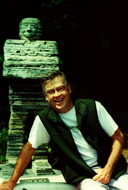
LE: Who are you?
LW: I grew up in Yakima, WA. in a family of orchard, wheat, and sugar beet farmers. A farmer, I would “NOT” become! From early on, I felt different from the rest. And knew the higher powers had something different in store for me. I was the black sheep, and it was a struggle to break away.
LE: What is your life history as it relates to being an artist?
LW: As far back as I can remember I was doing artwork. I was the first in our family to show any interest in art. My only early encouragement came from teachers and entering contests. I had won a bicycle back in grade school in a national contest sponsored by Post Cereal and the US Postal Service. That kind of made my family take note – Not!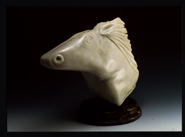
LE: Why did you become an artist?
LW: Living most of my childhood in the rural area, opportunities for playing with other kids, other than at school, were far and few between. I occupied myself by drawing and building things. Becoming an artist came natural to me.
LE: What key life experiences affected your direction in art?
LW: Animals and the country landscape were the closest at hand and playing in and around the old barns fascinated me. There seems to be a mystery or secret history to old buildings standing stoic and all alone. Art classes were always the highlight of my day. While in high school, I was one of the students chosen to mentor younger kids at a school for Creative Talented Students. Then I became interested in music and drama. I always wanted to be an actor first, and being an artist was my second choice. By the time I got to college, my major was Performing Arts: music, dance, and drama. I did take art classes for the fun of it, but the seventies abstract movement pushed me away. I wanted to paint in a realistic style and to capture things in their natural beauty. However, realism was TABOO. I think back and laugh now, because people were puzzled by my choice of major when I was already selling paintings at galleries. During this period, I felt “cursed” having these gifts! Others made me feel that I was NUTS!
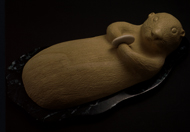
Did I want to be an Actor or an Artist? I subscribed to American Artist Magazine, and there was a featured article on the late actor, Henry Fonda. I was surprised to learn that he was an accomplished artist as well. This was an “awakening” that told me that I was “OK” after all! That it was all right to do both. He mentioned that he took his art supplies with him on sets and while doing plays in New York. In his trailer or room, he would set up a still life to paint. This was his way to relax. That article made such an impact on me that I wrote a letter to Mr. Fonda telling him about my frustrations and how his acting and being an artist influenced me. This gave me the courage to go with it! After sending this letter to the magazine and never expecting any thing from it, I just about passed out when I got a personal letter from Henry Fonda!
He was tickled pink that he had influenced a young man, and we started corresponding regularly. I was never “star struck,” since I knew that acting was only another job. This being personal, it was kept a college secret. I can proudly say that he and I have traded paintings. I have a wonderful still life of his that continues to remind me of this life experience.
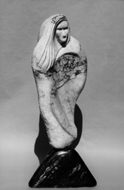
Then came an invitation to have a show in New York dedicated to my mentor - Henry Fonda. This show spawned an invitation to exhibit at The Center for Contemporary Art, in Paris, France. After college, I pursued acting and modeling and had jobs in print, TV, and film. I am blessed to have had these opportunities to perform with many well-known actors, and these experiences have taken me around the world. Being on the shy side, I could never just let go or get over the stage fright. I got tired of the B.S. of the business and the stress of auditioning. My heart was telling me that art was my calling, so I gave up the acting altogether in the late eighties. You think that it’s hard promoting yourself as an artist? Try showbiz!
LE: Who or what has influenced your art form?
LW: With my painting, Andrew Wyeth and Eric Sloane were my major influences. Wyeth’s strong, stark subjects and design captivated me. I understand how his subjects tell a story since so many of his paintings are of the same genre as mine. Sloane caught the essence and beauty of the disappearing landscape. Yes, I am nostalgic. I found it interesting that my early collectors could tell the difference in a painting that was painted from a found photograph and one painted from my own observation and studies from actually being there. The latter showed something more personal in them. With sculpture, of course, the great masters that we all studied influenced me at one time or another. Michelangelo’s works are amazing. I remember having a tear drop from my eye, the first time that I saw a real Michelangelo in person. I stood in awe at how lifelike it was. And could not believe that it was carved out of rock!
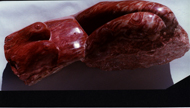
LE: Why is art important to you?
LW: Art is in my bloodstream. I think of art as a vital organ. Knowing how wonderful art is, and how good it feels to create, I would just be lost without it. How shallow and void the souls must be of those people who have zero hobbies or interests. Art helps me to know that I am alive, and it can offer visual pleasure to others.
LE: How does art reflect your philosophy?
LW: My philosophy always has been that the beauty of life and nature is so precious and plentiful; that one should tap all his God-given talents, pursue them to the best of his ability, and share with others everything he has to offer.
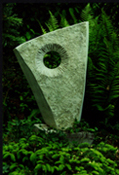
LE: How has NWSSA influenced your work as an artist?
LW: Before I came across the first symposium in Pateros, WA, something was lacking in the fulfillment category. That was it - stone carving! - the physical action of handling something tangible. It felt like a “workout,” moving stone around, chipping at it, reducing it by wielding a hammer, versus flipping a paintbrush. In addition, camaraderie and long friendships have grown from experiencing other artists and their styles, ideas, techniques, and skill levels. It’s an ever expanding acquisition of knowledge.
LE: Describe your art in your own terms.
LW: Most of my stone carving is representational of animals or plants - organic forms. I do an occasional abstract, non-rep once in a while. The latter is very difficult for me. I respect and admire those of you who do these styles. At least I can understand and feel what the non-representational artist is evoking. For me, I need to ‘see’ something and know where I am going.
LE: How do you get your ideas?
LW: My ideas start with the stone’s shape. I try to choose a stone that tells me what is inside of it.
LE: How do you develop them?
LW: Most of the time, I am pretty clear on the subject, and can visualize it as I carve directly into it. When I am in doubt or cannot see where I am going before making that cut, I will do some sketches or solve it in clay first. When I have a stone that I want to carve, but I am totally blank, I will make a piece of clay into the same shape as the stone. Then play with it until something becomes clear.
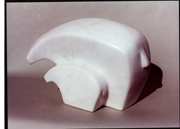
LE: What is the source of inspiration for your forms?
LW: I feel very close to all things in nature. Their beauty is what inspires me.
LE: What are you trying to express?
LW: I am hoping that the finished piece finally comes to life, or shows its ‘spirit’. Whether it is detailed or stylized.
LE: Describe a recent piece or two.
LW: I recently finished a large marble (large for me) of a polar bear and her cub napping, “Let Sleeping Bears Lie.” I did not want to put the eyes in since it is obvious what they are. I decided to leave it to the viewer’s imagination but I did not want them to look “dead.” It took me a long time to get those shapes so that they would evoke napping. This piece took so long, that I literally jumped for joy when it was there! Verena handed me a small piece of white alabaster this spring. (You know, she’s a granite queen). I carved a cat lying on its back, reaching over its legs to grab its tail, and called it “Tail Chaser.” The end result was pleasing enough to make a bronze edition of it. (Editor’s note: it won the Purchase Award at the 2003 Kenmore Art Show.)
LE: What do you like about some of the pieces you’ve done?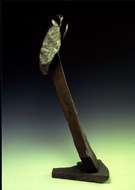
LW: I really enjoy the pieces that are abstract enough or stylized in design but still show their character. Better yet, are the ones where I can leave some of the skin or natural form of the stone. I like to see the sculpture, and yet be reminded that it is stone. I have been disqualified from juried shows for this as well. One unimaginative judge even told me to “carve the rest of it!”
LE: What is the major theme or intent of your art?
LW: I do mostly animals and plant forms.
LE: Do you do one piece, or work on several at a time?
LW: I work on several at a time. Pieces always need a resting period before I make the next move or process. The final sanding and finishing is the least creative part. So, I will start new ones while pieces are going through this stage.
LE: Do you work full or part time as an artist?
LW: During all those years of modeling and acting, my day job was in grocery. This paid well enough for me to work part-time, and still have the flexibility to pursue my passions. I have been retired for two years now from the grocery biz. I try to paint in the AM, (studio at home) and go over to the shop (ten minutes away) in the PM. I rent this wonderful shop space from metal sculptor, Jeff Tangen. (Some of you don’t know that I do large outdoor metal sculptures as well.)
LE: What stones do you prefer?
LW: I enjoy mostly marbles, alabaster, limestone, and chlorite.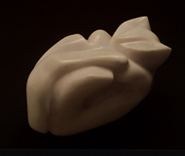
LE: How much work do you complete in a year?
LW: Never as much as I would like, 6-8 pieces, since it is divided with painting.
LE: Do you teach art?
LW: I have taught painting, but not sculpture, although mentoring is a pleasure.
LE: Have you been influenced by a particular artist?
LW: Seattle artist, Tony Angell’s wildlife sculptures are awesome to me, and inspire my stone sculptures. Calder and Alan Houser inspire my abstract side.
LE: What scale or size do you work in?
LW: Most of my stones are one-man pieces. I do have a few 200-300lb pieces, but that is probably the largest that I ever plan to work. I kind of envy those who have the stamina and equipment to handle large works. But I am content with what my body allows.
LE: How is your work area set up?
LW: My rented shop space has a nice gallery area, and a main tool shop with welding equipment. I can roll up the shop doors onto a large outside area for the dirty work, and a stone pile.
LE: Where do you exhibit your work?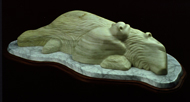
LW: The Kirsten, Gig Harbor, The Stillwater galleries when I have pieces, exhibits with the NWSSA, and juried shows. I have outdoor pieces currently at La Connor, Wenatchee, and Redmond.
LE: What have been your satisfactions in your life as an artist?
LW: I truly feel blessed that I have this creativity. Art expresses the soul. What pleases me is that I can create something that shares this pleasure with someone who wishes to have it. Art has kept me grounded in my most inner desires and provides a tangible meaning to my life on this planet.
LE: What obstacles and challenges have you overcome?
LW: The questions that every person wonders about - “where do I fit in?” and “what is my purpose?” Having reached that contentment to be truly happy with the person that I am, I can cherish every day that I have to create, share, and have loved ones and special people around me.
LE: What are you looking forward to?
LW: There are some pieces that I am hoping to make into bronzes. I do not have any wild, outstanding goals or projects. I just enjoy being in the moment. The results are always a surprise. I have resolved the “angst” that I will never complete my life’s list of goals, ideas, and projects. And I do not mean that in a negative way. That list will remain and continue to grow, but only so much can be done each day. And I am happy with each day’s work.
Finally, I just want to say that being a part of the NWSSA has enriched my life as an artist tremendously and has taken me on another road of life’s adventures with all of you. Just be happy with your own person and what makes you feel good from deep within. The rest just happens!

